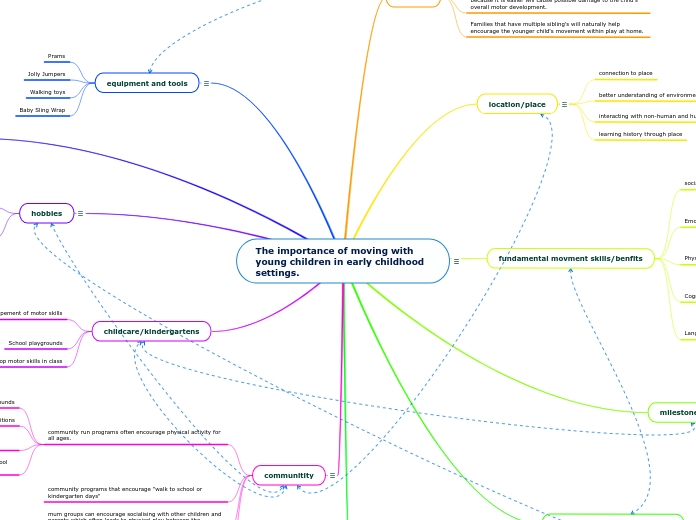The importance of moving with young children in early childhood settings.
families
Knowledge on the importance of motor development in young children will determine how helpful they are at providing the right recourses for their child.
most parents who are educated on this will enrol their child in physical activities and hobbies or encourage movement at home.
families who leave children on their technological devices because it is easier will cause possible damage to the child's overall motor development.
Families that have multiple sibling's will naturally help encourage the younger child's movement within play at home.
location/place
connection to place
better understanding of environment
will grow up to a more respectful generation in regards to environment
interacting with non-human and human entities
learning history through place
fundamental movment skills/benfits
social skill
Social skills give children the required knowledge to understand their social identity within this world (Developmental milestones and the Early Years Learning Framework and the National Quality Standards).
Emotional skill
This skill enables children to learn how to respond to diversity and make effective contributions to society (Developmental milestones and the Early Years Learning Framework and the National Quality Standards).
Physical Skill
When the physical skills are built children are able to look after their own health and wellbeing which will support them for life (Developmental milestones and the Early Years Learning Framework and the National Quality Standards).
Cognitive skill
This skill benefits children to form better understandings and meaning making within their play and education (Developmental milestones and the Early Years Learning Framework and the National Quality Standards).
Language Skill
Throughout learning the language skill children become increasingly better at being effective communicators (Developmental milestones and the Early Years Learning Framework and the National Quality Standards).
milestones
Capable of knowing if the child is advanced or even just on the right track, not necessarily to meet all requirements though as each child learns at their own pace.
Helps to figure out what the child will be learning next in order to plan activities and learning approaches ahead of time.
my own expereince and veiws
hobbies
School activities
family influence
things that encourage movement in children
chores or adult acitvities
games and music that require movment
outdoor play
equipment and tools
Prams
Jolly Jumpers
Walking toys
Baby Sling Wrap
Questions on this topic
Why isn't the importance of movement in young children advertised more within society?
hobbies
sports connects to many of the motor development skills required within young children
unique sports such as horse riding or ice skating and more, enable a high advancement in motor skills as some adults are not even capable of doing such tasks.
childcare/kindergartens
types of play that can assist in the devlopement of motor skills
unstructured play
structured play
School playgrounds
lesson planning to intentionally develop motor skills in class
communitity
community run programs often encourage physical activity for all ages.
parks and playgrounds
community based competitions
advertisements on physical activity within tv shows and advertisements
the council also run child programs for after school or school holidays which are heavily physical based.
community programs that encourage "walk to school or kindergarten days"
mum groups can encourage socialising with other children and parents which often leads to physical play between the children.
Active transport
